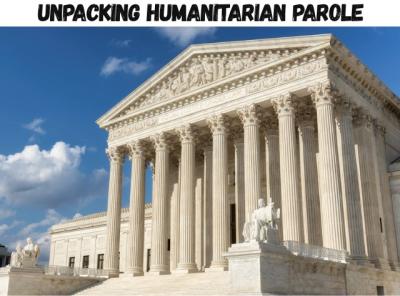
On May 30, 2025, the Supreme Court ruled that the administration could terminate the Biden-era humanitarian parole program known as CHNV, which allowed more than 500,000 people from Cuba, Haiti, Nicaragua, and Venezuela to enter the United States and remain temporarily for a period of two years. While not a final ruling, the Supreme Court’s order means that temporary protection for Cubans, Haitians, Nicaraguans, and Venezuelans who are already in the U.S. will no longer be in place while this case plays out in the lower courts. The case now returns to the 1st U.S. Circuit Court of Appeals in Boston, MA.
Many CHNV parolees are now at risk of deportation proceedings. A March 25 notice to the federal register indicates that the Department of Homeland Security intends to “remove promptly” CHNV parolees who do not have any lawful basis to remain in the United States, prioritizing those who had not filed an immigration benefit application before March 25, 2025. In other words, if they applied for asylum or a green card prior to the March 25 notice, they may have legal grounds to remain in the United States. All others can be deported at any time. Recent press reports indicate the Haitians could be sent to Guantanamo.
What is CHNV?
CHNV is a humanitarian parole program launched in late 2023 to provide humanitarian protection for nationals from Cuba, Haiti, Nicaragua, and Venezuela. It was modeled after the United for Ukraine (U4U) program that was launched in the spring of 2022 to welcome displaced Ukrainians as a result of the Russian invasion. CHNV utilized a private sponsorship model which required a U.S.-based sponsor to prove they had the financial means to support the CHNV national and to showcase why the individual merited parole. The CHNV national then had to go through background checks before receiving authorization to travel to a U.S. airport, where a Customs and Border Protection (CBP) official considered them for parole on an individual basis. CHNV was only available to people who were able to travel to the United States by air, not by land. Individuals from these countries who crossed at a land port of entry at the Southern border, were ineligible for the CHNV program.
CHNV was coupled with restrictions on access to asylum at the Southern U.S.-Mexico border for migrants from these nations. The Mexican government agreed to allow the United States to expel up to 30,000 migrants from Cuba, Haiti, Venezuela, and Nicaragua into Mexico each month. In short, migrants who crossed without authorization into Panama, Mexico, or the U.S. after the parole program was announced (in October 2022 for Venezuelans, January 2023 for Cubans, Haitians and Nicaraguans), were ineligible for the CHNV program or for asylum.
This coupling of humanitarian parole alongside harsher enforcement for other asylum seekers from the same countries was not utilized in the U4U program or in other humanitarian parole programs, like the one for Afghanistan. It’s also important to note that the CHNV program had maximum caps for arrivals. There were no maximums for the U4U program or the Afghanistan program, but the CHNV was capped at 30,000 people from each nation per month.
Why launch CHNV?
CHNV, and other humanitarian parole programs, exist as a tool for the administration to extend protection to a certain population for a temporary period of time. The creation and use of humanitarian parole programs ultimately derives from the 1952 Immigration and Nationality Act (INA) and have been used by multiple administrations to provide temporary entry to a group of people. The INA allows the government to “use their discretion to parole any noncitizen applying for admission into the U.S. temporarily for urgent humanitarian reasons or significant public benefit.” Several administrations have leveraged humanitarian parole since its enactment - first with 30,000 Hungarians in the 1950s. The Migration Policy Institute reports that it was then used again in the 1960s and in the 1970s for Chinese and Vietnamese, respectively.
Partly in response to these situations, Congress then passed the Refugee Act of 1980 in recognition of a growing need for a more streamlined process of protection to those fleeing violence. Fast forward to present day and we have a refugee processing and asylum system that remains excruciatingly slow, with average wait times of four years (source).
The U.S. has long been the world leader in refugee resettlement, but the number of refugees allowed in the presidential determination each year is relatively low. For FY23, it was set at 125,000. Like many other aspects of our immigration system, there is a huge backlog in the refugee and asylum process system. (Remember: Asylum and refugee status are two different processes and statuses. A person is granted refugee status overseas, whereas a person applies for asylum upon arrival in the U.S. Here’s a brief overview of the difference with thanks to Amnesty International).
Because of this complex and time-consuming system, U.S. administrations have required a way to quickly process certain groups of individuals for protection. This is why humanitarian parole has been so valuable. CHNV however, was controversial because in addition to providing protection for this population, it was coupled with policies that allowed for expelling migrants upon encounter at the border, thus calling into question the purpose of the policy in the first place. If the purpose were humanitarian, then wouldn’t migrants encountered at the border be equally in need of protection? The way the policy was implemented makes the justification appear more political than humanitarian, and Quixote Center has heard from numerous partners in Haiti and Nicaragua that the policy led to a “brain drain” from those countries and was destabilizing. In addition, the way in which the Biden administration launched CHNV and associated policies has ‘vastly outstripped past administrations’ use of this authority’ (source).
When the Biden administration launched CHNV in 2022 for Venezuelans, the justification listed in the federal register was that country conditions indicated parole was an urgent humanitarian imperative. As Refugees International highlights, the federal notices also justified the parole programs as being in the public interest because they would “reduce reliance on smugglers to cross between land border ports of entry and instead allow for pre-vetted migration through airports to supporters in the United States.” This is, in fact, what happened.
What, then, is the purpose of providing a protective status that is temporary? Historically, when humanitarian parole was launched due to a widespread conflict or crisis, the administration worked with Congress to grant those individuals a pathway to legal status, through the passage of adjustment legislation that allows parolees to apply for a green card. Another option used by previous administrations is extending the timeframe for protection. As the Biden administration’s time in office came to a close, it announced that it would not create a re-parole process for CHNV participants; instead, parolees were told to apply for another status such as Temporary Protected Status (TPS), visa, green card, or asylum. The Quixote Center is aligned with Refugees International’s assessment that “The Biden administration should have announced this earlier and helped parolees understand what they were eligible for and how to apply because some parolees believed other statuses were incompatible with their parole.”
What was the impact of CHNV?
Within a few months of the program’s launch, U.S. Citizenship and Immigration Services (USCIS) received 1.5 million applications, enough to fill the CHNV allocation caps for more than four years (source). By the end of 2024, 110,240 Cubans, 211,040 Haitians, 93,080 Nicaraguans, and 117,320 Venezuelans had arrived in the U.S. and were granted parole through CHNV, 532,000 people in total (source). As one of the largest humanitarian parole programs in recent history, it was bound to have a turbulent reception.
The Texas government, along with other states, sued the Biden administration in 2023 citing CHNV as a drain on state resources (source). House Republicans called CHNV a “a fraud-ridden unmitigated disaster” (source) and were one of the first to term the program a “pull factor” for migrants. Still others have showcased how this particular policy has played out in Nicaragua, where the evidence indicates that migration from Nicaragua to the U.S. increased as a result of the program, and that an “urgent humanitarian imperative” was lacking.
The other side of the argument indicates that the program has “has reduced border arrivals and relieved pressure on city governments. In fact, survey data indicate that those paroled through the CHNV process disperse throughout the country, initially depend on sponsors and not government, and are becoming economically self-sufficient in a short period of time.”
What now?
While the Supreme Court’s ruling is not the final ruling, it undoubtedly places thousands of our immigrant brothers and sisters in legal limbo. The case now returns to the 1st U.S. Circuit Court of Appeals in Boston, MA.
Because of the impact on migrants, the Quixote Center stands firmly against the current administration’s revocation of CHNV. We also recognize what humanitarian parole is (and has been): a temporary status which can be granted or revoked based on the ebb and flow of political administrations. It is a temporary protection that leaves migrants without a status or foundation to fall back on, which is increasingly dangerous when the U.S. is as politically divided as we are today.
Our immigration and protection system is convoluted and complex and does not meet the needs of the myriad reasons people choose to migrate, or our current geopolitical climate. The legal pathways available to migrants and their families are deeply restrictive: “legal immigration is less like waiting in line and more like winning the lottery.” We need to move beyond temporary solutions and codify safe and non-exploitative legal pathways that recognize the important role immigrants play in our society and economy.
Sources and Further Reading:
CBP Releases November 2024 Monthly Update: https://www.cbp.gov/newsroom/national-media-release/cbp-releases-november-2024-monthly-update
National Archive Federal Register, Termination of Parole Processes for Cubans, Haitians, Nicaraguans, and Venezuelans: https://www.federalregister.gov/documents/2025/03/25/2025-05128/termination-of-parole-processes-for-cubans-haitians-nicaraguans-and-venezuelans
Washington Post, Trump to Ramp up Deportations to Guantanamo, including Citizens of Allies: https://www.washingtonpost.com/national-security/2025/06/10/trump-guantanamo-deportations/
American Immigration Council Fact Sheet: The Biden Administration’s Humanitarian Parole Program for Cubans, Haitians, Nicaraguans, and Venezuelans: An Overview: https://www.americanimmigrationcouncil.org/research/biden-administrations-humanitarian-parole-program-cubans-haitians-nicaraguans-and
AP News, Supreme Court lets Trump end legal protections for 500,000 migrants, exposing more to deportation: https://apnews.com/article/trump-supreme-court-immigration-deportation-8bc46820c6444fbb3540c09764e32905
Migration Policy Institute, In the Twilight Zone: Record Number of U.S. Immigrants Are in Limbo Statuses: https://www.migrationpolicy.org/article/twilight-immigration-status
National Archives, Refugee Act of 1980: https://archivesfoundation.org/documents/refugee-act-1980/
Amnesty International, Refugees, Aslyum Seekers and Migrants: https://www.amnesty.org/en/what-we-do/refugees-asylum-seekers-and-migrants/
Fwd.US, Legal Pathways with Private Sponsorship Have Been Successful in Reducing Unauthorized Migration to the Border and Protecting Displaced People: https://www.fwd.us/news/legal-pathways-successful/
Refugees International, Setting the Record Straight on CHNV: https://www.refugeesinternational.org/perspectives-and-commentaries/setting-the-record-straight-on-chnv/ National Immigration Forum Explainer: Humanitarian Parole: https://immigrationforum.org/article/explainer-humanitarian-parole/
National Immigration Forum Explainer: What We Can Learn from Prior Adjustment Acts and What They Mean for Afghan Resettlement: https://immigrationforum.org/article/explainer-what-we-can-learn-from-prior-adjustment-acts-and-what-they-mean-for-afghan-resettlement/
CBS News, 1.5 million apply for U.S. migrant sponsorship program with 30,000 monthly cap: https://www.cbsnews.com/news/us-migrant-sponsorship-program-cuba-haiti-nicaragua-venezuela-applications/
Refugees International, Q&A: What Is at Stake as the Biden Administration’s CHNV Parole Program Goes on Trial?: https://www.refugeesinternational.org/qa-what-is-at-stake-as-the-biden-administrations-chnv-parole-program-goes-on-trial/
Covert Action Magazine: Nicaraguan Immigration Down Despite U.S. Efforts to Encourage It: https://covertactionmagazine.com/2023/05/18/nicaraguan-immigration-down-despite-u-s-efforts-to-encourage-it/
FWD.us, Survey data show the administration’s parole policy for the Americas is a successful model for new legal pathways: https://www.fwd.us/news/chnv-parole/?q=1
FWD.us, Industries with critical labor shortages added hundreds of thousands of workers through immigration parole: https://www.fwd.us/news/immigration-labor-shortages/
Migration Policy Institute, Is the Humanitarian Protection System Falling Apart or Quietly Evolving?: https://www.migrationpolicy.org/article/humanitarian-protection-evolution
American Immigration Council, The Use of Parole Under Immigration Law: https://www.americanimmigrationcouncil.org/research/use-parole-under-immigration-law
The Cato Institute, Why Legal Immigration is Nearly Impossible: https://www.cato.org/policy-analysis/why-legal-immigration-nearly-impossible#overview-legal-immigration


